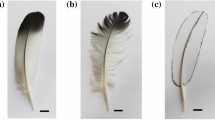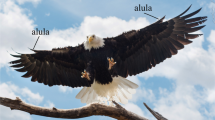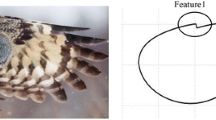Abstract
Birds have gradually formed various excellent structures such as streamlined shape and hollow shaft of feather to improve their flying performance by millions of years of natural selection. As typical property of bird feather, herringbone riblets align along the shaft of each feather, which is caused by perfect link of barbs, especially for the primary and secondary feathers of wings. Such herringbone riblets of feather are assumed to have great impact on drag reduction. In this paper, microstructures of secondary feathers of adult pigeons are investigated by SEM, and their structural parameters are statistically obtained. Based on quantitative analysis of feather structure, novel biomimetic herringbone riblets with narrow smooth edge are proposed to reduce surface drag. In comparison with traditional microgroove riblets and other drag reduction structures, the drag reduction rate of the proposed biomimetic herringbone riblets is experimentally clarified up to 16%, much higher than others. Moreover, the drag reduction mechanism of herringbone riblets are also confirmed and exploited by CFD.
Similar content being viewed by others
References
Dean B, Bhushan B. Shark-skin surfaces for fluid-drag reduction in turbulent flow: A review. Philosophical Transactions of the Royal Society A, 2010, 368, 4775–4806.
Dean B, Bhushan B. The effect of riblets in rectangular duct flow. Applied Surface Science, 2012, 258, 3936–3947.
Walsh M J. Riblets as a viscous drag reduction technique. AIAA Journal, 1983, 21, 485–486.
Walsh M J, Lindemann A M. Optimization and Application of Riblets for Turbulent Drag Reduction. American Institute of Aeronautics and Astronautics, New York, USA, 1984, 347, 1–11.
Choi K S. European drag-reduction research — recent developments and current status. Fluid Dynamics Research, 2000, 26. 325–335.
Choi K S, Yang X, Clayton B R, Glover E J, Altar M, Semenov B N, Kulik V M. Turbulent drag reduction using compliant surfaces. Proceedings of the Royal Society A, 1997, 453, 2229–2240.
Bechert D W, Bruse M, Hage W, Van Der Hoeven J G T, Hoppe G. Experiments on drag-reducing surfaces and their optimization with an adjustable geometry. Journal of Fluid Mechanics, 1997, 338, 59–87.
Philip B. Engineering shark skin and other solutions. Nature, 1999, 400, 507–509.
Tucker A V, Parrott C G. Aerodynamics of gliding flight in a falcon and other birds. The Journal of Experimental Biology, 1970, 52, 345–367.
Nachtigall W. Starlings and starling models in wind tunnels. Journal of Avian Biology, 1998, 29, 478–484.
Homberger D G, De Silva K N. Functional microanatomy of the feather-bearing integument: implications for the evolution of birds and avian flight. American Zoologist, 2000, 40, 553–574.
Parfitt Alex R, Vincent Julian F V. Drag reduction in a swimming humboldt penguin, spheniscus humboldti, when the boundary layer is turbulent. Journal of Bionic Engineering, 2005, 2, 57–62.
Tian L M, Ren L Q, Han Z W, Zhang S C. Experiment about drag reduction of bionic non-smooth surface in low speed wind tunnel. Journal of Bionic Engineering, 2005, 2, 15–24.
Tian L M, Ren L Q, Liu Qing P, Han Z W, Jiang X. The mechanism of drag reduction around bodies of revolution using bionic non-smooth surfaces. Journal of Bionic Engineering, 2007, 4, 109–116.
Chen K, Liu Q P, Liao G H, Yang Y, Ren L Q, Yang H X, Chen X. The sound suppression characteristics of wing feather of owl (Bubo bubo). Journal of Bionic Engineering, 2012, 9, 192–199.
Shi L., Zhang C C, Wang J, Ren L Q. Numerical simulation of the effect of bionic serrated structures on the aerodynamic noise of a circular cylinder. Journal of Bionic Engineering, 2012, 9, 91–98.
Bachmann T, Klan S, Baumgartner W, Klaas M, Schröder W, Wagner H. Morphometric characterisation of wing feathers of the barn owl Tyto alba pratincola and the pigeon Columba livia. Frontiers in Zoology, 2007, 4, 23.
Yaws C L. Braker W. Matheson Gas Data Book, 7th ed, McGraw-Hill Professional, New York, USA, 2001.
Rohr J J, Andersen G W, Reidy L W, Hendricks E W. A comparison of the drag-reducing benefits of riblets in internal and external flows. Experiments in Fluids, 1992, 13, 361–368.
Author information
Authors and Affiliations
Corresponding author
Rights and permissions
About this article
Cite this article
Chen, H., Rao, F., Shang, X. et al. Biomimetic Drag Reduction Study on Herringbone Riblets of Bird Feather. J Bionic Eng 10, 341–349 (2013). https://doi.org/10.1016/S1672-6529(13)60229-2
Published:
Issue Date:
DOI: https://doi.org/10.1016/S1672-6529(13)60229-2




